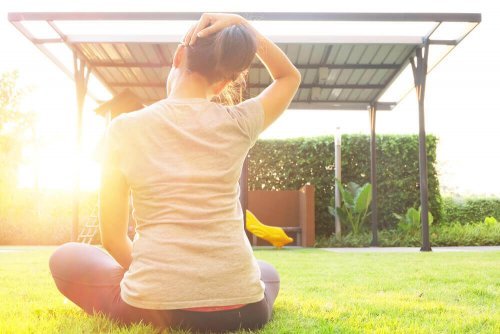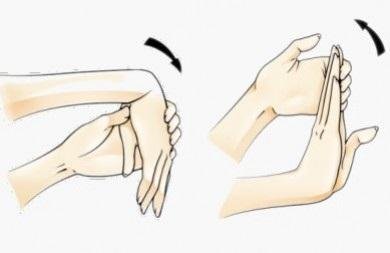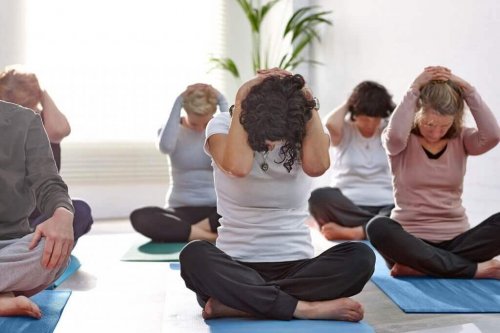Four Movements That Will Help You Avoid Headaches Caused by Muscle Tension

There are many types of headaches and we’ve all felt one at least once. They can be deafening, pulsating, localized or diffuse, mild, or extremely strong. Some last a few minutes and others up to several days, which can be really annoying. Muscle tension could be one of the triggers.
We usually classify headaches as tension headaches, migraines, or cluster headaches. Tension migraines are characterized by causing pain on only one side of the head. Most headaches originate from muscular tension, often due to stress.
Muscle tension due to stress
Emotions have an immediate effect on our bodies. A negative experience can express itself on a physical level in just a few seconds. When we feel any kind of stress, we automatically contract certain muscle groups. Once the stressful situation disappears, the muscles relax.
The muscles that tense up the most due to stress are the ones in the jaw, eyes, mouth, neck, and back. It’s a reflex reaction that occurs as a protection mechanism and it isn’t harmful in itself. The problem appears when stress is prolonged and becomes chronic.

When the previous situation occurs, the muscles remain in a state of permanent tension, instead of relaxing. This muscle tension causes a decrease in blood flow to the affected area.
This is how chronic muscle pain, contractures, and constant headaches appear. Some go away with over-the-counter pain relievers, but others can be really hard to fight.
Movements that relieve headaches caused by muscle tension
A relaxing massage can help to alleviate a headache caused by muscle tension. For example, it’s been proven that massages on the neck, head, and spine relieve tension pain in the skull.
Doing some exercises for a few minutes a day can also be very useful. You can do these exercises at home, at any time, and they are very simple. Moreover, they don’t require much space or special clothing. It’s mainly stretching exercises that help relieve headaches.
Neck and shoulder stretches
You can do these exercises standing up or sitting down. The important thing is to be relaxed and to keep your back straight. It involves moving the neck and then the shoulders from front to back for approximately 30 seconds. These movements will serve to increase the elasticity of the contracted tissues and relieve muscle tension.

Head and chin movements
Just like the previous exercise, you can stand or sit, but always with your back straight. To perform this stretching exercise, you should tilt your head towards your chest and slowly bring your chin towards your right shoulder. You have to maintain this pose for approximately 30 seconds.
While doing this movement, you will feel a strong stretch on the left side of your neck and the upper left part of the back. After that, you make the same movement on the opposite side. It’s preferable to repeat this exercise at least three times on each side.

Stretching your back and wrists
Stand up with your back straight, take your left wrist with your right hand and pull it for 30 seconds. Then, repeat the exercise by pulling the right wrist with the left hand. We recommend you perform 3 repetitions on each side.

Head inclination
While standing up or sitting, keep your back straight and move your head gently from right to left for 30 seconds. After that, you repeat, but this time the movement of your head goes up and down for 30 seconds. Similarly, tilt your head with the ear towards the shoulder from one side to the other for 30 seconds.

Finally, incline your head and rotate it, forming a half circle from one side to the other for 30 seconds. Then, repeat the same movement with your head tilted back. To finish, make full rotations from one side to the other for 30 seconds as well.
These exercises favor blood flow to the muscles of the neck, thereby relieving muscle tension in the area. Performing these movements also aids proper muscular recovery.
There are many types of headaches and we’ve all felt one at least once. They can be deafening, pulsating, localized or diffuse, mild, or extremely strong. Some last a few minutes and others up to several days, which can be really annoying. Muscle tension could be one of the triggers.
We usually classify headaches as tension headaches, migraines, or cluster headaches. Tension migraines are characterized by causing pain on only one side of the head. Most headaches originate from muscular tension, often due to stress.
Muscle tension due to stress
Emotions have an immediate effect on our bodies. A negative experience can express itself on a physical level in just a few seconds. When we feel any kind of stress, we automatically contract certain muscle groups. Once the stressful situation disappears, the muscles relax.
The muscles that tense up the most due to stress are the ones in the jaw, eyes, mouth, neck, and back. It’s a reflex reaction that occurs as a protection mechanism and it isn’t harmful in itself. The problem appears when stress is prolonged and becomes chronic.

When the previous situation occurs, the muscles remain in a state of permanent tension, instead of relaxing. This muscle tension causes a decrease in blood flow to the affected area.
This is how chronic muscle pain, contractures, and constant headaches appear. Some go away with over-the-counter pain relievers, but others can be really hard to fight.
Movements that relieve headaches caused by muscle tension
A relaxing massage can help to alleviate a headache caused by muscle tension. For example, it’s been proven that massages on the neck, head, and spine relieve tension pain in the skull.
Doing some exercises for a few minutes a day can also be very useful. You can do these exercises at home, at any time, and they are very simple. Moreover, they don’t require much space or special clothing. It’s mainly stretching exercises that help relieve headaches.
Neck and shoulder stretches
You can do these exercises standing up or sitting down. The important thing is to be relaxed and to keep your back straight. It involves moving the neck and then the shoulders from front to back for approximately 30 seconds. These movements will serve to increase the elasticity of the contracted tissues and relieve muscle tension.

Head and chin movements
Just like the previous exercise, you can stand or sit, but always with your back straight. To perform this stretching exercise, you should tilt your head towards your chest and slowly bring your chin towards your right shoulder. You have to maintain this pose for approximately 30 seconds.
While doing this movement, you will feel a strong stretch on the left side of your neck and the upper left part of the back. After that, you make the same movement on the opposite side. It’s preferable to repeat this exercise at least three times on each side.

Stretching your back and wrists
Stand up with your back straight, take your left wrist with your right hand and pull it for 30 seconds. Then, repeat the exercise by pulling the right wrist with the left hand. We recommend you perform 3 repetitions on each side.

Head inclination
While standing up or sitting, keep your back straight and move your head gently from right to left for 30 seconds. After that, you repeat, but this time the movement of your head goes up and down for 30 seconds. Similarly, tilt your head with the ear towards the shoulder from one side to the other for 30 seconds.

Finally, incline your head and rotate it, forming a half circle from one side to the other for 30 seconds. Then, repeat the same movement with your head tilted back. To finish, make full rotations from one side to the other for 30 seconds as well.
These exercises favor blood flow to the muscles of the neck, thereby relieving muscle tension in the area. Performing these movements also aids proper muscular recovery.
All cited sources were thoroughly reviewed by our team to ensure their quality, reliability, currency, and validity. The bibliography of this article was considered reliable and of academic or scientific accuracy.
- Martin-Escudero, Pilar & Galindo Canales, Mercedes. (2010). Ejercicio físico y Migraña.
- Urbano Quesada, Bárbara. 2015. Cefalea tensional. Universidad de Jaén. Extraído de: http://tauja.ujaen.es/bitstream/10953.1/1538/1/TFG%20URBANO_QUESADA_B%C3%81RBARA.pdf
This text is provided for informational purposes only and does not replace consultation with a professional. If in doubt, consult your specialist.








